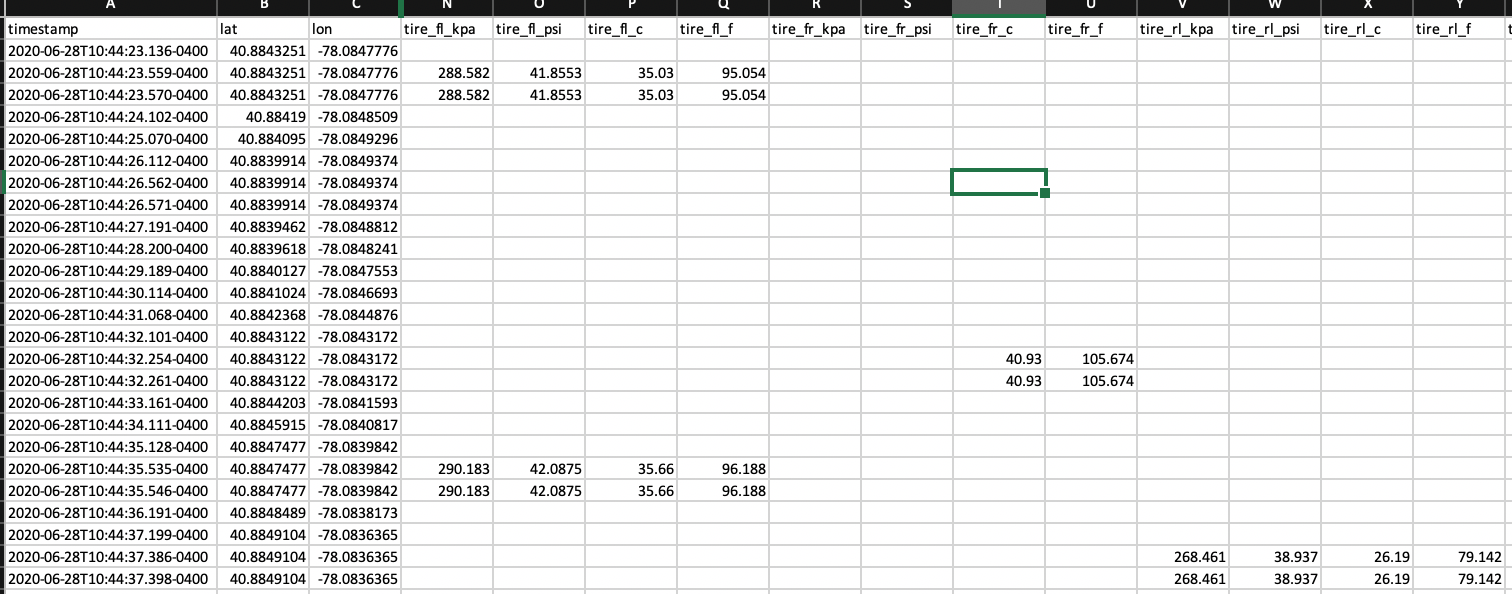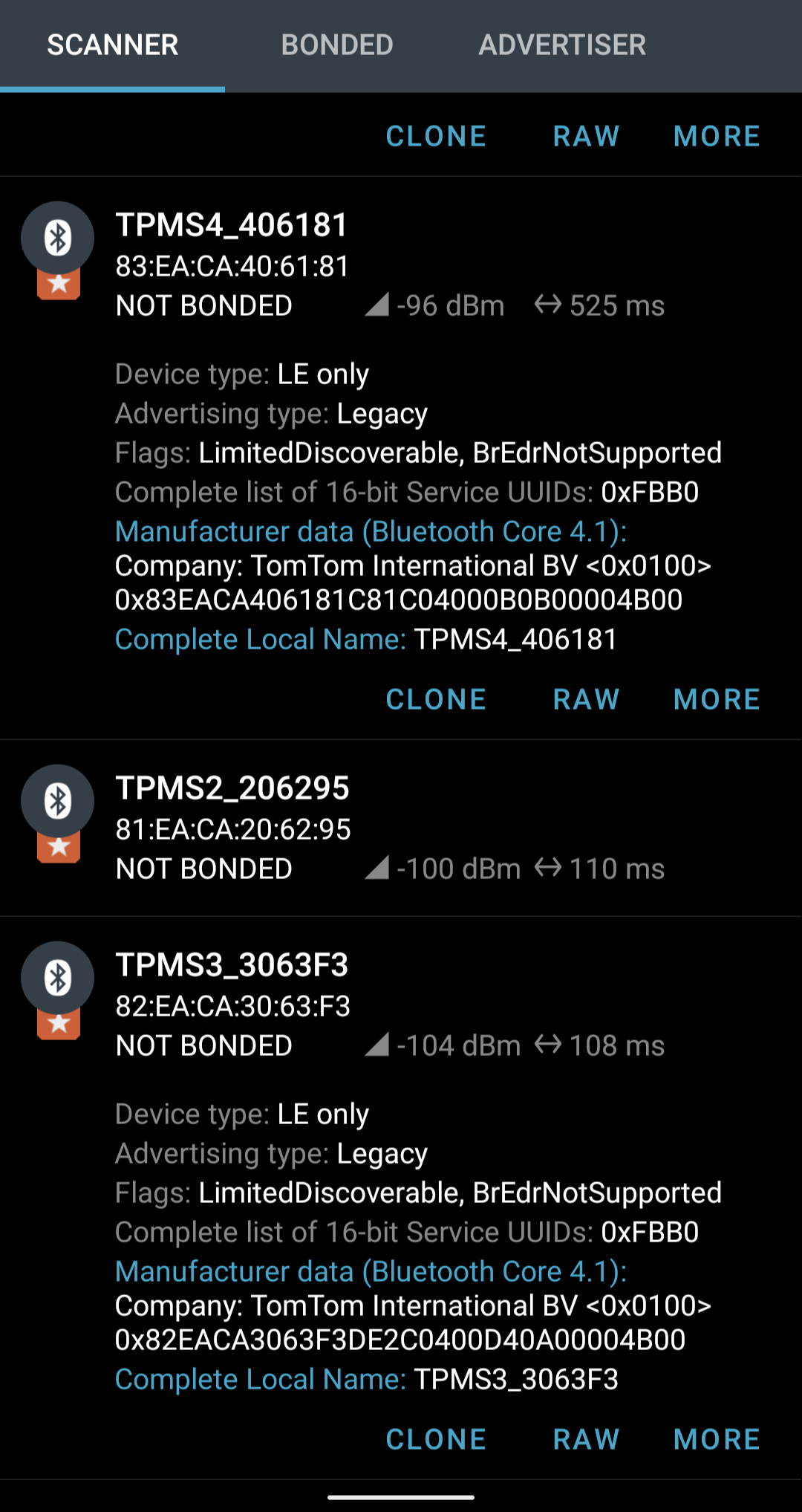THIS REPO LIVES AT THE FOLLOWING URL NOW: https://0xacab.org/mtigas/iOS-BLE-Tire-Logger •••••• or via tor: http://wmj5kiic7b6kjplpbvwadnht2nh2qnkbnqtcv3dyvpqtz7ssbssftxid.onion/mtigas/iOS-BLE-Tire-Logger
iOS TPMS Data Logger (for BLE tire pressure sensors, inc. “TP630”, “ZEEPIN”, etc)
© 2020, Mike Tigas; MPL-2.0 License
A tiny utility for super cheap BLE tire pressure/temperature sensors available on the internet. Most of these products do have their own apps (i.e. this one) which don’t have features beyond displaying the values (in various units) and providing bounds alerts (for low air pressure, etc) while the app is open. See Device Details below for example devices & where to buy them.
I wanted something to use alongside RaceChrono which I am currently using as a data logger with dash cam footage, particularly when putting together video from autocross and similar events in RaceRender:
Notes:
- I threw this together really quickly (literally over a weekend) so everything is still very rough. It’s very much just a minimum viable thing that’s usable for my own purposes (like that above video).
- It has not been submitted to the App Store, though I may do so in the future, once there are fewer things hard-coded and once there are a few more UI bits in here.
- I’m currently running iOS betas and using the current Xcode 12 Beta (for iOS 14, etc). So apologies if this does not build cleanly on other versions yet.
This app looks for BLE sensors that advertise the 0xFBB0 service. See Device details below for some example devices. These devices usually advertise a name that looks like TPMS1_1ABC23, where the number 1 is something from 1-4.
Any sensor starting with TPMS1_ is assumed to be the front-left tire, TPMS2_ front-right, TPMS3_ rear-left, and TPMS4_ rear-right. (So as-is, this logger will definitely pick up interfering datapoints if another car has similar sensors.)
Data is saved as a CSV to the app’s documentDirectory, and is accessible in the iOS Files app or in the Files section of the iOS device sync screen of MacOS: On My iPhone/BLE Tire Logger/data-YYY-MM-DDTHHMMSS.csv
See doc/EXAMPLE-data-2020-06-28T103840.csv, which is an export from the autocross event in the above video.

Device details
- I personally ordered this one which unfortunately no longer seems to be available. I got the “external” one, which replaces the valve stem cap. (Total cost was $36.61 including tax, with free ePacket shipping that took about seven weeks to arrive to the USA.)
- This ricallinson/tpms project links over to this “ZEEPIN TPMS Sensor Bluetooth Low Energy Tire Pressure Monitoring System”.
- I have seen a few other posts around the internet refer to these as “TP630”.
Using the free nRF Connect app, raw information from the installed sensors can be seen here:

In the package that I received, each sensor advertises a name of TPMS{N}_{MMMMMM}, where {N} is a one-digit index (1, 2, 3, 4) and {MMMMMM} is a six hex character MAC address suffix (i.e. 3063F3); upon closer examination, it looks like N is the first digit of MMMMMM. In the packaging, these indexes and IDs are provided on an index card with bar codes to be scanned by the manufacturer’s app. Per the packaging, 1 goes to front-left, 2 goes to front-right, 3 to rear-left, and 4 to rear-right; however, this does not seem to be an important distinction, since having the IDs means that we can keep track of these by ourself.
The devices advertise the BLE Service ID 0xFBB0. The devices cannot be connected or paired to and the devices do not receive any incoming BLE characteristics/packets/etc; all data is broadcast as part of the “Manufacturer data” portion of the BLE advertisement. In the above screenshot, that 16-byte manufacturer data (for sensor 3) looks like this (spaces added by me):
0x 83 EA CA 40 61 81 C8 1C 04 00 0B 0B 00 00 4B 00
I discovered ricallinson/tpms, which contained excellent information on extracting temperature and pressure from the BLE “manufacturer data” (CBAdvertisementDataManufacturerDataKey) part of the BLE advertisement. Bytes 8,9,10,11 are a representation of the air pressure in kPA, and bytes 12,13,14,15 represent the temperature in Celsius, both as little-endian 32bit unsigned integers that need some scale conversion; pseudocode:
pressure_kilopascal = Uint32(bytes[8:11]) / 1000
pressure_celsikus = Uint32(bytes[12:15]) / 100
Checking this against the values in manufacturer’s app suggests that this is is accurate.
Output details
iOS’ CoreBluetooth is used to listen for the advertisement packets (CBCentralManager.scanForPeripherals(...)). The sensors do not stream data constantly, and because of the way BLE polling and advertising works (and because the sensors do not support being connected to or paired with), there is a chance that iOS may miss a given advertisement. As you can see in the example above, values for the sensors are only filled in when they are received; this codebase does not interpolate values between readings.
User location is also requested with the highest accuracy supported by the device. This is currently required to use the app
A CSV row is written any time there is either a location update OR a new BLE advertisement received from a tire sensor.
